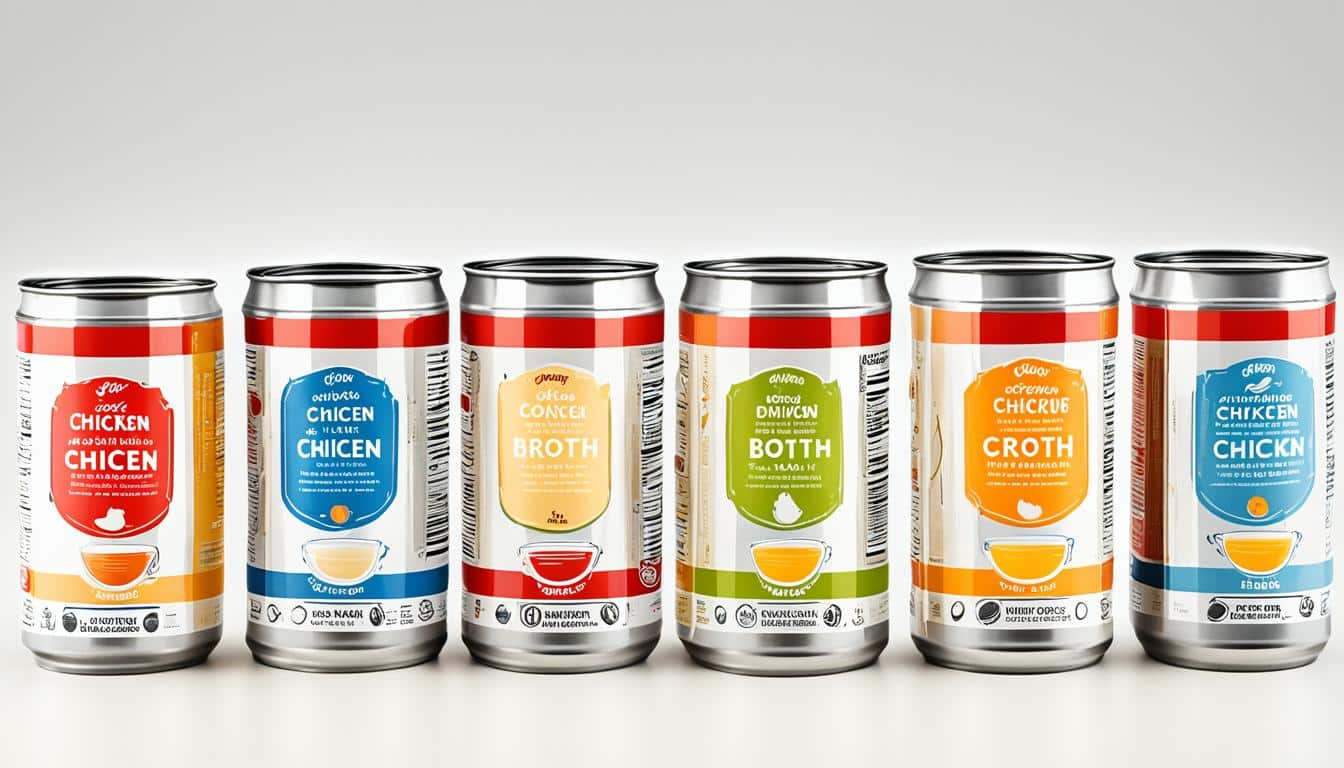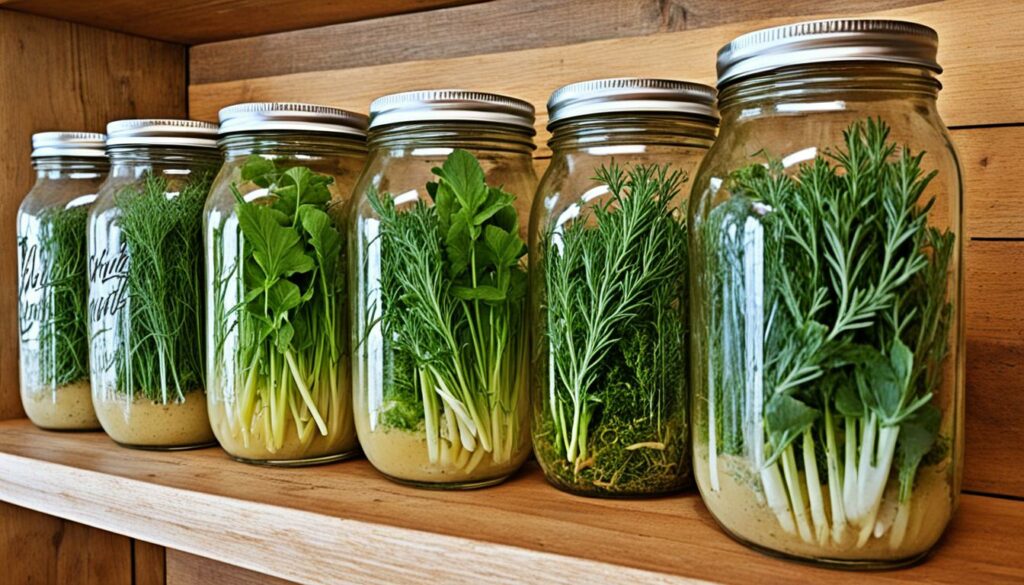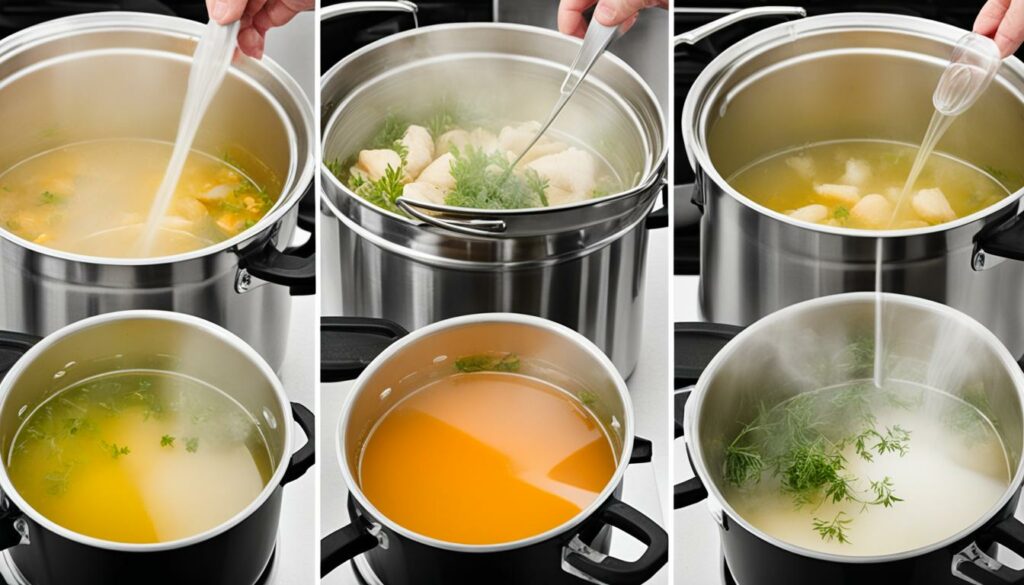
Canning chicken broth is a fantastic way to preserve homemade bone broth without taking up valuable freezer space. But before you start planning your canning projects, you may be wondering just how much chicken broth you’ll find inside each can. Let’s dive into the various can sizes and determine the exact quantity of chicken broth you can expect to have at your fingertips.
Key Takeaways:
- Understanding the can sizes will help you accurately determine the amount of chicken broth you’ll have.
- Canning chicken broth provides convenient access to homemade stock for a variety of recipes.
- Proper canning techniques ensure that your chicken broth remains safe and delicious for long-term storage.
- Experimenting with different can sizes allows for flexibility in portioning and cooking measurements.
- By canning chicken broth, you’ll always have a flavorful and nutritious ingredient ready in your pantry.
How to Pressure Can Homemade Stock/Broth
To pressure can homemade stock or broth, you will need a pressure canner, canning jars, and the ingredients to make the stock. The process involves simmering the bones and vegetables in a large stockpot or slow cooker, straining the stock into glass containers, and then pressure canning it for a specific amount of time. This ensures your homemade stock is safely preserved for long-term storage.
Step-by-Step Guide to Pressure Canning Homemade Stock
If you’re new to pressure canning, don’t worry! Follow these simple steps to ensure a successful canning process:
- Start by preparing your ingredients. Gather bones, vegetables, herbs, and spices to make your flavorful stock.
- Simmer the ingredients in a large stockpot or slow cooker until the stock is rich and aromatic.
- Once the stock is ready, strain it into clean canning jars, leaving about 1 inch of headspace at the top.
- Wipe the rims of the jars clean to ensure a proper seal.
- Place the lids and screw on the bands fingertip tight.
- Load the jars into the pressure canner, following the manufacturer’s instructions for proper placement.
- Close the lid of the pressure canner and adjust the heat to build pressure.
- Process the jars at the recommended pressure and time according to your canner’s manual.
- Once the processing time is complete, turn off the heat and let the canner depressurize naturally.
- Carefully remove the jars from the canner and let them cool undisturbed on a clean towel or cooling rack.
- Check the jars for proper seals before storing them in a cool, dark pantry.
By following these steps, you’ll have perfectly preserved homemade stock or broth ready to enhance the flavors of your culinary creations whenever you need it.
How to Can Homemade Stock or Broth
Canning homemade stock or broth is a simple process that requires canning jars, sealing lids, and the ingredients for your stock. By following these steps, you can safely preserve your homemade stock for long-term storage.
- Simmer: Start by simmering the bones, vegetables, and seasonings in a large stockpot or slow cooker to extract all the flavors and nutrients. This step is essential for creating a delicious and nutritious stock.
- Strain: Once the stock has simmered for the appropriate amount of time, strain it through a fine-mesh sieve or cheesecloth to remove any solids. This will result in a clear and smooth broth.
- Jar: Pour the strained stock into clean canning jars, leaving about 1 inch of headspace at the top. This headspace allows for expansion during the canning process.
- Wipe: Before sealing the jars, wipe the rims with a clean cloth or paper towel moistened with vinegar. This step ensures that the jars are clean and free from any residue that could interfere with the sealing process.
- Seal: Place the sealing lids on the jars and securely tighten the bands. The lids and bands should be in good condition to ensure a proper seal.
- Canner: Transfer the sealed jars into a pressure canner. Follow the instructions provided with your specific canner for correct pressure settings and processing times based on your altitude and the size of the jars.
- Process: Once the canner is at the correct pressure, begin the processing time according to your canner’s manual. This step ensures that any bacteria or pathogens are effectively killed, making your stock safe for long-term storage.
- Cool: After the processing time is complete, turn off the heat and allow the canner to depressurize naturally. Once the pressure has been released, carefully remove the jars from the canner and let them cool completely.
- Store: Once the jars have cooled, check the seals to ensure they are tight and intact. Label the jars with the contents and the date of canning, then store them in a cool, dark pantry for future use.
Following these steps will allow you to enjoy the convenience of having homemade stock or broth readily available whenever you need it. Whether you use it as a base for soups, stews, sauces, or to add flavor to various dishes, your canned stock will elevate your culinary creations.

Tips for Successful Canning:
Always use high-quality canning jars and sealing lids to ensure a proper seal.
Properly sanitize all equipment and jars before use to prevent contamination.
Follow the altitude adjustment guidelines provided with your pressure canner to ensure accurate processing times.
Label your canned stock with the date of canning for easy organization and tracking.
Inspect jars for any signs of spoilage before consuming the stock. If a jar’s seal is compromised or if the contents appear cloudy, moldy, or have an off smell, discard it.
Canning Bone Broth or Stock (Chicken, Beef, or Vegetable)
Canning bone broth or stock is a simple and effective method to preserve the rich flavors and valuable nutrients of homemade broths. Whether you’re making chicken, beef, or vegetable broth, the canning process remains the same. By pressure canning the broth, you ensure its safety for long-term storage, allowing you to have a constant supply of flavorful and nourishing broth on hand.
Pressure canning is a recommended method for canning bone broth due to its low acidity. This process involves using a pressure canner to achieve the high temperatures required for safely preserving low-acid foods. It eliminates the risk of spoilage and harmful bacteria, ensuring the longevity of your homemade stock.
When canning bone broth, start by preparing a batch of your desired broth recipe. Whether you prefer the comforting taste of chicken, the robustness of beef, or the flavors of vegetables, choose high-quality ingredients to enhance the overall taste of your broth.
Once your broth is ready, carefully transfer it to clean canning jars, leaving adequate headspace to allow for expansion during processing. Wipe the rims of the jars with a clean, damp cloth to ensure a proper seal.
Next, secure the lids onto the jars according to the manufacturer’s instructions. The sealed jars should be placed in a pressure canner filled with the appropriate amount of water. Follow the specific processing time and pressure guidelines recommended for your altitude and jar size to achieve safe canning.
After the processing time is complete, let the pressure canner naturally depressurize before removing the jars. Once cooled, check the lids for proper sealing. Any unsealed jars should be refrigerated and used within a few days.
When storing your canned bone broth or stock, choose a cool and dark location, such as a pantry or cellar. Properly canned broth can be safely stored for up to a year or more, ensuring you have a reliable supply whenever you need it.
By canning bone broth or stock, you not only preserve their delicious flavors and nourishing qualities but also create convenience for future use. Whether you’re making soups, stews, or other savory dishes, having canned broth readily available allows you to enhance the taste and nutritional value of your meals effortlessly.
| Type of Broth | Canning Process |
|---|---|
| Chicken | Roast chicken bones, simmer with vegetables and seasonings, strain, and pressure can. |
| Beef | Simmer beef bones with vegetables and seasonings, strain, and pressure can. |
| Vegetable | Simmer vegetable scraps and seasonings, strain, and pressure can. |

Canning Chicken Bone Broth Step By Step
When it comes to preserving the rich flavors and health benefits of chicken bone broth, canning is an excellent option that ensures long-term storage. By following a few simple steps, you can enjoy the convenience of having your homemade chicken bone broth readily available whenever you need it.
Step 1: Prepare the Chicken Bone Broth
To begin, start by roasting the bones to enhance the depth of flavor. You can use a combination of chicken carcasses, wings, or drumsticks, along with any vegetables and seasonings of your choice. Once the bones are roasted to perfection, transfer them to a stockpot, add water, and bring it to a gentle simmer.
Step 2: Simmer and Skim
Allow the broth to simmer for several hours, skimming off any impurities or foam that may rise to the surface. This process helps clarify the broth and ensure a clean and smooth final product. During the simmering process, the flavors intensify, creating a robust and savory chicken bone broth.
Step 3: Strain and Season
Once the bone broth has simmered to perfection, strain it through a fine-mesh sieve or cheesecloth to remove any solid particles. This ensures a clear and silky-smooth broth. At this point, you can adjust the seasoning to your taste preferences, adding salt, pepper, herbs, or spices for an extra burst of flavor.
Step 4: Transfer to Canning Jars
With your chicken bone broth ready, it’s time to transfer it to clean and sterile canning jars. Fill the jars, leaving about an inch of headspace at the top. This space allows for expansion during the canning process and helps preserve the broth’s quality and integrity.
Step 5: Process in a Pressure Canner
Using a pressure canner is essential for safely canning chicken bone broth. Follow the manufacturer’s instructions for your specific canner model to ensure proper usage. Each canner has its own pressure and processing time recommendations, so be sure to adjust accordingly. The processing time will also depend on the size of your canning jars, as smaller jars may require less time than larger ones.
Step 6: Altitude Adjustments
Altitude can affect the processing time required for canning chicken bone broth. At higher altitudes, where the atmospheric pressure is lower, you will need to adjust the processing time to ensure the proper canning temperature and safety. Consult a reliable altitude adjustment chart or contact your local extension office for guidance on adjusting the processing time based on your specific altitude.
By following these steps, you can confidently can your delicious homemade chicken bone broth and enjoy the convenience of having it readily available in your pantry for a variety of culinary creations.
Step-by-Step Guide: Canning Chicken Broth
When it comes to canning chicken broth, the process remains the same regardless of whether you’re using a Dutch oven or a slow cooker to make your broth. Follow these steps to ensure a successful canning process:
- Prepare your pressure canner: Before you begin the canning process, make sure your pressure canner is clean, in good working condition, and has the necessary amount of water in it. Refer to the manufacturer’s instructions for specific guidelines.
- Fill the jars with hot broth: Fill your clean canning jars with hot chicken broth, leaving about 1 inch of headspace at the top. This headspace allows for sufficient expansion during the canning process.
- Remove air bubbles: Gently tap the filled jars on a sturdy surface to release any trapped air bubbles. This step ensures that the jars are properly filled and the broth is evenly distributed.
- Wipe the rims clean: Use a clean, damp cloth or paper towel to wipe the rims of the jars. This step removes any residue or food particles that could interfere with the sealing process.
- Seal the jars: Place the sealing lids on the jars and tighten the bands until they are fingertip tight. Avoid over-tightening, as it can prevent air from escaping during the canning process.
- Load the jars into the pressure canner: Carefully place the filled and sealed jars into the pressure canner, taking care not to overcrowd them. Allow for proper water circulation and heat distribution.
- Bring it up to pressure: Following the manufacturer’s instructions, bring the pressure canner up to the recommended pressure for canning chicken broth. This is typically around 10-11 pounds of pressure.
- Process for the recommended time: Once the canner reaches the appropriate pressure, start the timer and process the jars for the recommended time. This time may vary depending on your altitude and the jar size being used.
- Let the canner depressurize naturally: Once the processing time is complete, turn off the heat and allow the pressure canner to depressurize naturally. Do not attempt to release the pressure manually.
- Remove the jars: Once the canner has depressurized and the pressure indicator has dropped, carefully remove the jars from the canner and place them on a heat-resistant surface to cool.
Altitude adjustments may be necessary when canning chicken broth to ensure accurate processing times. Consult a reliable canning resource or the National Center for Home Food Preservation for specific guidelines based on your location.
By following these steps and taking the necessary precautions, you can safely can your homemade chicken broth using the hot pack method and pressure canner.
How to Serve Chicken Bone Broth
Chicken bone broth is a versatile and nutritious ingredient that can be enjoyed in various ways. Whether you prefer to savor it on its own or use it as a base for delicious dishes, there are numerous serving suggestions to explore. Here are some ideas to inspire you:
1. Enjoy it as a sippable, nourishing drink
Heat up a comforting cup of chicken bone broth and sip on it as a warming and nutrient-packed beverage. This is a great option for those seeking a comforting and hydrating drink that is packed with flavor and health benefits.
2. Make a heartier meal
Elevate the chicken bone broth by adding extra ingredients to create a satisfying and nutritious meal. Consider adding cooked noodles, such as rice noodles or egg noodles, for a comforting bowl of broth with a substantial texture. You can also add vegetables like carrots, celery, and leafy greens to introduce more vitamins and minerals into your meal. For added protein and texture, adding shredded chicken or cooked grains like quinoa or barley can be a great option.
3. Explore different flavor profiles
Each batch of chicken bone broth can have unique flavors and aromas, allowing you to experiment with different seasoning combinations. Try adding herbs like thyme, rosemary, or parsley to enhance the taste profile. A dash of lemon juice or apple cider vinegar can add a tangy twist. Don’t be afraid to get creative and customize the flavor profile according to your taste preferences.
4. Use it as a cooking ingredient
Chicken bone broth is a fantastic base for soups, stews, gravies, and sauces. Its rich flavors and nutritious properties can enhance the taste of your favorite recipes. Use it as a substitute for water when cooking rice or quinoa to infuse extra flavor into your grains. The possibilities are endless, so don’t hesitate to incorporate chicken bone broth into your culinary creations.
With its versatility and nourishing qualities, chicken bone broth is a fantastic addition to your mealtime repertoire. Experiment with different serving suggestions and let your taste buds guide you towards delightful and nutritious meals.
Conclusion
Canning chicken broth is an essential method for preserving homemade stock and ensuring long-term pantry storage. By following proper canning procedures, you can conveniently have a ready supply of flavorful and nutritious homemade chicken broth whenever you need it. Whether you use it as a base for soups, stews, or other recipes, or simply enjoy it on its own, homemade stock adds depth of flavor and richness to your dishes.
With homemade chicken broth at your fingertips, you can elevate your cooking to new heights. The process of canning chicken broth allows you to preserve the goodness of your homemade stock without the need for additional freezer space. It’s a great way to ensure that you always have a versatile ingredient on hand to enhance the flavor of your culinary creations.
Having a stock of canned chicken broth in your pantry provides you with tremendous culinary flexibility. You can use it as a base for hearty soups, comforting stews, or quick and flavorful sauces. The convenience of canned homemade stock allows you to whip up a nutritious and delicious meal in no time, without compromising on taste or quality.
In conclusion, canning chicken broth is a simple and effective way to store homemade stock for future use. With proper preservation techniques, you can enjoy the convenience and versatility of homemade chicken broth, elevating your cooking to a whole new level.
FAQ
How much chicken broth is in a can?
The quantity of chicken broth in a can typically varies depending on the brand and size of the can. Common can sizes for chicken broth include 14 ounces, 32 ounces, and 48 ounces. It’s always best to check the label or product description for the specific amount of chicken broth contained in each can.
What are the dimensions of a chicken broth can?
The dimensions of a chicken broth can can vary based on the brand and size. However, most standard-sized chicken broth cans have a diameter of around 2.5 to 3 inches and a height of around 4 to 5 inches. Again, it’s recommended to consult the product packaging or description for the precise dimensions of the can.
How do I determine the amount of chicken broth in a can?
To determine the amount of chicken broth in a can, you can either refer to the label or product description, which usually states the quantity, or you can measure it yourself using a measuring cup or kitchen scale. If the can does not include this information, measuring the contents manually will give you an accurate estimate of the chicken broth quantity.
What is the volume of canned chicken broth?
The volume of canned chicken broth can vary depending on the size of the can. Common can sizes include 14 ounces, 32 ounces, and 48 ounces. To determine the specific volume, refer to the label or product description, which typically provides this information.
How can I calculate the amount of chicken broth in a can?
Calculating the amount of chicken broth in a can is relatively straightforward. First, refer to the label or product description for the specified quantity. If that information is not available, you can manually measure the broth using a measuring cup or kitchen scale. By doing so, you’ll be able to determine the precise amount of chicken broth in the can.
